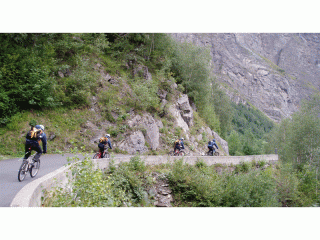It is also important to train in as many different environments to which you have access. Proficiency on a placid lake will not translate to a raging river or a choppy bay. Last, always train with your teammates on the water. The obvious safety factor aside, you almost always paddle in a two to four person boat in an adventure race; hence, you need to develop a rhythm with your teammates.
Mountain biking
Perhaps it is only my perception, but it seems as though most adventure racers already have a background in mountain biking. Given the prevalence of the discipline today, it might surprise many newer adventure racers that mountain biking did not become a staple in the sport until the mid-1990’s.
Whether to buy a lighter weight hard-tail or a heavier, more forgiving duel suspension bike is a matter of personal preference. In any event, this choice is of lesser importance than properly rigging the bike for adventure racing.
One essential consideration is a lighting system. I still bear the scars on my knees from a harrowing crash in the Scottish Highlands that resulted from my refusal to carry a heavier, but higher quality light on my bike (the cheap version did not survive the constant impact of the rough terrain).
Experienced teams grapple with weight to the point of obsession, but in some cases the extra weight is offset by its benefits, and this is one of them. The added light enables faster speeds over undulating terrain at night, and this more than compensates for the added weight. At the very least, outfit one member of the team with a powerful light. Niterider is the sport’s most popular brand.
The strongest biker (or bikers) on your team should outfit their bike with tow lines. Some teams prefer to tape a caribiner on the head unit of the bike, with a retractable dog leash attached under the bike seat (remove the metal latch at the end and knot the end of the leash to wrap around the caribiner). My team generally opts for surgical tubing with loops tied at both ends of the caribiner, in part because this system converts more easily to running sections than towing a teammate with a dog leash (though the visual does offer some comic relief).
As with running and paddling, you need to have food easily accessible for the bike sections. We use a combination of Camelbaks for hydration, and handy little “Bento Boxes” mounted on our cross tubes for knick-knacks, electrolyte tabs, and other items likely to be needed for quick access.
